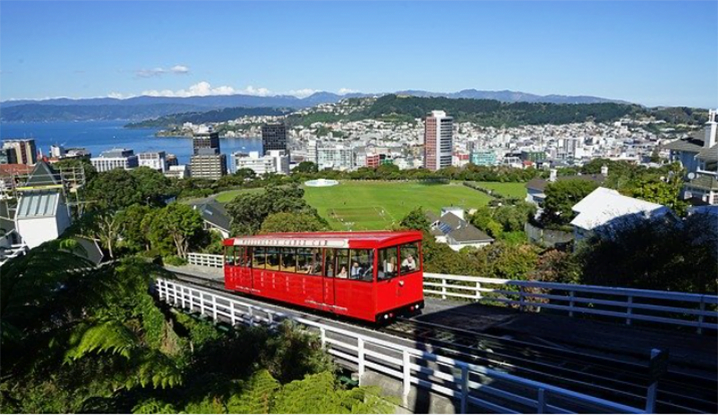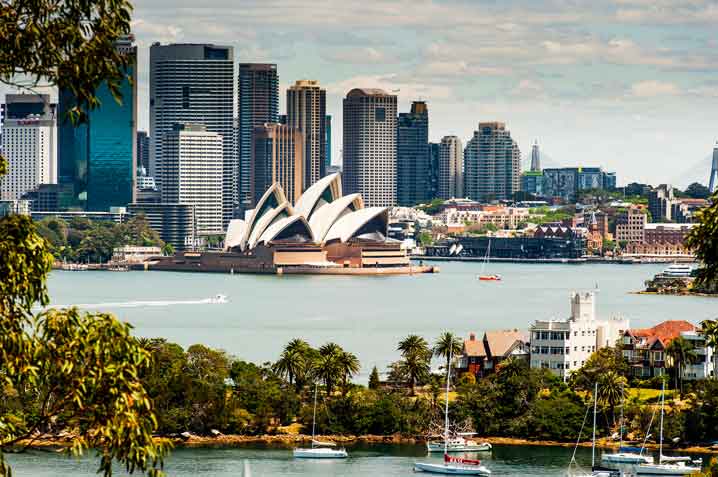Author: admin
Five places to visit in New Zealand!
New Zealand is one of the most beautiful countries in the world and is a beloved tourism destination. Five places to visit in New Zealand To help you plan your trip to New Zealand, we have compiled a list of five popular tourist attractions for you to visit in the country, once borders are reopened for travel!
1. Tongariro National Park
One of the first national parks in the world and the oldest in New Zealand, the Tongariro National Park is a treasure-trove of nature’s beauty consisting of undisturbed forests, volcanoes, hot springs and turquoise lakes.
2. Bay of Islands
A heaven for all adventure-seeking tourists, the Bay of Islands offers tourist activities such as hiking on the trails and a wide range of water sports, including swimming with dolphins, scuba diving, kayaking, yachting and fishing. You might even spot the whales peaking if you’re lucky!
3. Queenstown
Renowned as the adventure capital of New Zealand, Queenstown pulls thrill-seekers in like a magnet. From bungee-jumping, paragliding and rock climbing to downhill skiing, jet-boating and mounting biking – Queenstown has it all!
4. Manukau and Waitemata Harbours
Auckland’s gems, the Manukau Harbour and the Waitemata Harbour, draws in tourists from all around the world to its sparkling seafronts. The unique black and gold beaches are phenomenal and are a must-visit in Auckland!
5. Milford Sound
Declared as the “eighth wonder of the world” by British writer Rudyard Kipling in the 1890s, New Zealand’s Milford Sound is an idyllic landscape bathed in nature as you’ve never seen before – glaciers dating back to the Ice Age and cliffs rising from fjords, crowned by picturesque waterfalls and mountains. You can immerse yourself in the surroundings with a boat trip and even catch glimpses of dolphins and penguins in this magical tranquillity!

Five places to visit in New Zealand
Permanent Migrants of Australia and their Origins
India, England and China are the main origins of Australia’s two million permanent migrants, according to new figures.
The data, released by the Australian Bureau of Statistics, also disclosed that more than half of them are purchasing or trying to purchase their own property.
The 2016 Australian Census and Migrants Integrated Dataset revealed that around 2.2 million migrants arrived in the country since the turn of the millennium.
It also found that about 58% of the migrants were granted a skilled visa, 32% arrived by means of the family stream and only 10% of them were on humanitarian visas.
India was the top provider of migrants with skilled visas (19%), followed by England (13%) and China (12%).
On the other hand, China was the top country of birth (14%) of migrants arriving in Australia via the family stream, followed by England (8.8%) and India (8.3%).
Of the migrants who were granted humanitarian visas, Iraq was the top country of birth (18%), followed by Afghanistan (12%).
The figures went on to reveal that about 54% of the permanent migrants, aged 15 and above, were in the process of owning their own home.
Family stream migrants were the most likely to own their home outright (14%), while skilled migrants followed closely (8%).
The productivity of skilled migrants would result in a visible increase in the economic benefit of both the country and its residents.

Permanent Migrants of Australia and their Origins
Six things a Business Person should know about Migrating to Australia
Six things a Business Person should know about Migrating to Australia. The Business Innovation Stream (subclass visa) is intended for business owners and investors who have a proven history in successful business ownership and management for at least the last four years. This visa is very popular with overseas business people, and there are some distinctive things you should be aware of.
1. Points tested
An applicant for the innovation stream is required to satisfy the Business Innovation and Investment Points Test. According to the prescribed legislative instrument IMMI 12/041, the minimum number of points needed to be satisfied is 65. All points are calculated at the time of invitation to apply for a visa.
2. No academic or English proficiency requirement
Even though applicants can gain points for having academic credentials, it is not a mandatory requirement. Similarly, English proficiency is not a threshold requirement either.
There are second instalment fees (second VAC) that apply to visa applicants of at least 18 years of age that cannot satisfy the Functional English requirement. It includes both the primary applicant and any secondary dependent applicants. These fees are intended to pay for English language courses for the applicants once they arrive in Australia.
3. Can include family members, including parents
All Subclass 188 visa applicants and visa holders are entitled to include members of their family unit as secondary applicants. Members of the family unit are defined under Reg. 1.12 of the Migration Regulations 1994 as including spouse, dependent children, and dependent relatives.
4. No investment before the visa
The Business Innovation Stream requires that the business and personal assets of the applicant and their spouse or de facto partner together be lawfully acquired and are available for transfer to Australia within two years after the grant of the subclass 188 visa.
5. Can be extended, meaning more flexibility
When an applicant has been granted a subclass 188 visa and has held this visa for a period of three years or more, they may be entitled to apply for a Business Innovation Extension Stream Visa. This visa essentially extends their subclass 188 visa for a total period of six years granted from the date of the initial visa grant.
The Business Innovation Extension Stream visa contains criteria that are generally more relaxed than the requirements to be met for the initial subclass 188 visa application. There is still a requirement to maintain State of Territory nomination, although this usually is satisfied so long as the initial nomination is not withdrawn.
6. It can lead to Australian citizenship
The Business and Innovation stream visa can lead to Australian citizenship. For that, applicants need to fulfil the following criteria to satisfy the citizenship requirement:
- are a permanent resident at the time of application and time of decision
- meet the residence requirements
- are of good character
- intend to reside in or maintain a close and continuing association with Australia.
- have adequate knowledge of the responsibilities and privileges of Australian citizenship.
Proactive business people win in the end
The Business Innovation Stream visa program has proven to be a successful one; the number of applications and eagerness among the overseas business community says it all. If a business person fulfils the prerequisites and wants a new beginning in Australia, they should step forward immediately. They can apply for this visa on their own, or get support from an Australian registered and recognised immigration consultant.
According to Australian law, only registered consultants can legally give immigration assistance. If someone finds it difficult to apply by themselves, eduaid is here to help them out. Contact us today and an Australian immigration consultant will directly communicate with you for an obligation-free initial consultation.

Six things a Business Person should know about Migrating to Australia
High Immigration Levels more Boon than Bane, says Reserve Bank Governor
Australia’s healthy rate of immigration was lauded by the country’s Reserve Bank governor Philip Lowe for its contribution to growth at a recent event in Sydney. High Immigration Levels more Boon than Bane, says Reserve Bank Governor.
According to Lowe, the high immigration levels have had only positive impacts on the economy.
It has also helped to pacify the rate of the ageing of population in recent years.
This has resulted in Australia having not only one of the youngest populations amongst the advanced economies worldwide, but also a higher fertility rate and better prospects for growth.
Lowe appreciated the scores of young people who moved to Australia in the past decade, as the numbers had a very positive impact on the nation’s demographic.
He drew focus to the fact that back in 2002, the population’s median age was estimated to cross 45 years by 2040.
However, thanks to the growth in the number of youths over a decade, the latest estimate projected the median age to be around 40 years by 2040.
Lowe praised this statistic in particular, and said that this is a prime example which shows that demographic trends are not set in stone.
Data shows that on average, new migrants to Australia in recent years have been younger than the resident population.
The median age of recent migrants sits between 20 and 25, which is more than 10 years younger than that of Australian locals.
This proved to be a massive factor in stifling the rate of population ageing in Australia, and resulted in the population ageing more slowly now.
Moreover, the Australian population has a higher fertility rate than most advanced economies now, as well as having a lower old-age dependency ratio.
“This has implications for future economic growth and the pressures of government budgets,” said Lowe.
The benefits will be available both in the short term as well as the long run, as the unemployment rate is expected to fall to 5% – possibly even lower – in the next few years, and is presumed to sustain.

High Immigration Levels more Boon than Bane
Benefit of having Skilled Migrants: Hidden in Plain Sight
Focusing on skilled migration has allowed Australia’s educational standard of the workforce to rise rapidly, according to an OECD study.
Benefit of having Skilled Migrants: There has been a much recent political debate in Australia regarding immigration. It has been a popular ground for political debate, with both the current and former Prime Ministers getting involved.
It all started in February, when former Prime Minister Tony Abbott called for a reduction in the annual number of immigrants, claiming that cutting the number of immigrants seeking pastures new in Australia would improve the quality of living for the locals.
However, this claim was vehemently opposed by numerous fronts, including former Prime Minister Malcolm Turnbull and current Prime Minister Scott Morrison, as well as a number of leading business bodies and unions, who formed a rare alliance in order to retain the current immigration policy and numbers.
Now, the case for Australia’s migrant intake to remain the same gets even further backing by the results of an OECD study, which shows that the educational standard of Australia’s workforce is rising rapidly, with both migrants and new entrants to the labor force having higher educational standards than their retiree counterparts.
Illustrated by numbers, this result is even more striking. Between 2005 – 2015, the number of people in the workforce with tertiary educational qualifications saw a 37 percent increase, which is more than the 21 percent increase seen by the United States.
Furthermore, this increase in Australia’s tertiary educated workforce was more than three times the 11 percent increase in the workforce overall. This analysis shows that migration lifts the overall education standard of the workforce while having only a temporary effect on the age profile of the workforce. Win-win.
At present, the educational profile of Australia’s workforce is polarized. Skilled migrants seeking career opportunities have higher qualifications as opposed to refugees and family reunion migrants.
This makes the case for skilled migrants even stronger, as the OECD names Australia as the only country where migrants have higher average educational standards compared to local employees. The numbers speak for themselves: 62 percent of recent migrants have tertiary education, while the same can be said for a lesser 55 percent of the young, new entrants.
Consequently, in the decade leading to 2015, Australia’s tertiary educated labor force rose by 40 percent. In comparison, the United States saw a 23 percent increase, while Europe was further back at 16 percent.
According to the study, Australia has been the most marked among those with lower educational standards. The aforementioned decade saw the retirement of almost one million lesser-educated members of the workforce, meaning the number of such workers dropped by almost 60 percent.
With their replacements being skilled migrants with higher educational standards, this has resulted in a marked improvement in the overall educational standard of the workforce.
Hence, apart from ensuring that having skilled migrants is more boon than bane, it sends a clear challenge to Tony Abbott’s proposal: Good luck changing the immigration policy!






